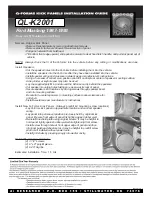S
U
P
E
R
V
IS
E
M
O
D
E
39
The dark grey section on the left includes the loudspeaker’s input and output monitoring facilities, identification fields, and basic oper-
ating controls: Power On/Standby, the Wink Light toggle, Wink with Audio, Input Gain, Polarity Invert, and Mute. Any or all of these con-
trols may be restricted to authorized operators and subject to password-protected access.
The loudspeaker icons on the right each have “traffic light” status indicators; green is for all OK and red is for driver failure. Yellow indi-
cates the driver has repeatedly been driven far enough into limiting that its normal life span may have been reduced. The traffic light
conditions are mirrored in the status field of the supervise icons. Driver conditions are dynamically supervised with program material
but an additional test button can confirm coil status. The use of these manual test buttons is required in case the program material
either lacks specific frequencies or is too weak.
Notice that all of the drivers in the array are being monitored and that each Array module has its own Wink light. During setup this
allows you to easily identify each array module and verify that its address number switches are properly set. If you press the Wink light
for the top module and the wink light on the middle module comes on, you know the switches are set wrong.
The loudspeaker’s RHAON Microcontroller and DSP Firmware version and MAC (Machine Access Control) address are shown in a
darker grey panel at the bottom right of this window.
The panel at the bottom displays the status of the Voltage Detect (Fault Monitoring) and Fault Relay circuits, the Priority Override func-
tion and the Ethernet inputs.
The Priority Override indicator will change from showing “Inactive” to “Active” when the override circuit is in use (has been activated).
The Fault Relay status line will change from “Off” to “On” when an amplifier fault has been detected or the Ethernet carrier signal is
lost.
The Voltage Detect will read “High” when it senses a voltage on the Sense input line and “Unknown when no voltage is present.
The Ethernet Status will show “Primary” when an Ethernet Carrier signal is detected at the Primary Ethernet input and “Off Line” if the
carrier signal is lost, except in “Redundant” systems having a secondary Ethernet source. In these systems, the amplifier will be
switched over to the secondary input as soon as the primary signal is lost; the status line will then change to Secondary”.
Users Manual
IC-R


















